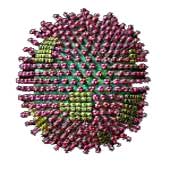The H5N1 virus has resisted Tamiflu
At first, a 13-year-old bird flu patient seemed lucky when she had only mild inflammation on one side of her lungs and was treated immediately with Tamiflu. However, after a few days of waking up, the patient became short of breath and died quickly - a sign that the H5N1 virus was resistant to the drug.
 "The patient was present at a hospital in Dong Thap Province, Vietnam on January 22 after a day of coughing and fever," said Dr. Menno de Jong from the HCMC Tropical Hospital and colleagues. After a few days, the drug seemed to work. However, the girl suddenly had difficulty breathing and needed more oxygen, the pneumonia became worse quickly. Eventually the patient died after 6 days of hospitalization.
"The patient was present at a hospital in Dong Thap Province, Vietnam on January 22 after a day of coughing and fever," said Dr. Menno de Jong from the HCMC Tropical Hospital and colleagues. After a few days, the drug seemed to work. However, the girl suddenly had difficulty breathing and needed more oxygen, the pneumonia became worse quickly. Eventually the patient died after 6 days of hospitalization.
Test results in Hong Kong showed that the virus attacked the girl suddenly mutated in a "immune" way to Tamiflu. The patient had a "H274Y replacement factor in the neuraminidase enzyme - a sign of high resistance to oseltamivir (Tamiflu's brand name)," the authors stated in a report published in the New England Journal of Medicine. .
A similar phenomenon occurs with some patients treated with the same drug group. At least 4 out of 8 people who were treated with Tamiflu died.
For a long time, it is not surprising that viruses often develop resistance to drugs, which is why AIDS treatment requires a mixture of drugs."The best way to prevent the risk of drug resistance is to inhibit the division of cells more thoroughly and as soon as possible. The model of 'hitting hard and beating early' which is used in the treatment of HIV / AIDS is also effective for the disease. influenza and many other viral infections, " de Jong said.
Tamiflu is one of two anti-influenza drugs of the neuraminidase inhibitor group. They target a protein on the surface of a cell called sialic acid, called "gate" inside the cell. Influenza viruses often use an enzyme called neuraminidase (which is the letter N in H5N1) to "open" this gate and enter the healthy cells.
Tamiflu has the ability to control neuraminidase enzymes, thus preventing the virus from attaching to the "gate" of sialic acid. However, influenza viruses tend to evolve and change constantly, so the neuraminidase enzyme structure also changes. Consequently, Tamiflu cannot completely neutralize neuraminidase. "The structural limitations of Tamiflu are susceptible to weakening after a few mutations of the virus, allowing the neuraminidase molecule to conserve and remain active," said Dr. Anne Moscona, a specialist in viral diseases in children and adults. Cornell (USA), said.
Meanwhile, the structure of a generic drug, Relenza of GlaxoSmithKline, "is somewhat different so it limits virus resistance to better drugs . " However, Relenza (also known as the zanamivir brand) has its own limitations: one is a spray in a spray form, so it is not suitable for some patients, and the other is only effective in the lungs, while H5N1 attacking other agencies.
My Linh (according to Reuters)
- Tamiflu: New regimen to treat H5N1 flu
- Upcoming drugs to fight H1N1 virus
- Flu is usually good for Tamiflu
- Detection of Tamiflu resistant virus
- Vietnam has the ability to recycle Tamiflu which has expired
- Detecting variants of Tamiflu-resistant influenza A / H1N1 virus
- H5N1 deformed in Egypt
- Do not rely too much on Tamiflu
- Discovering new compounds better than influenza A / H1N1 virus than Tamiflu
- Bad developments in H5N1 in Asia and Europe
- Detection of the H5N1 virus strain by a test
- H5N1 flu appears in poultry in Ninh Thuan
 March 2012: Launching H5N1 vaccine for poultry
March 2012: Launching H5N1 vaccine for poultry Experts comment on the mysterious gradual disappearance of the Delta variant in Japan
Experts comment on the mysterious gradual disappearance of the Delta variant in Japan Danger of the two Delta . branch variants
Danger of the two Delta . branch variants 2020 pandemic flu attack humans?
2020 pandemic flu attack humans?